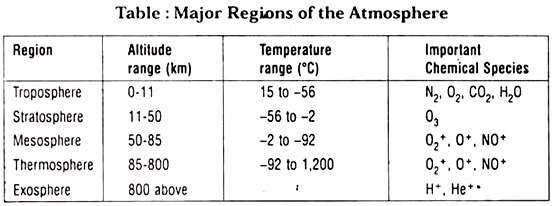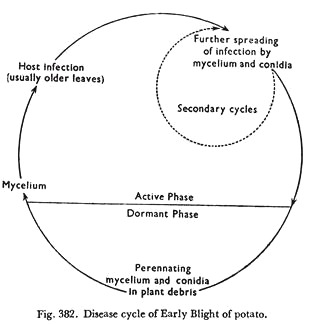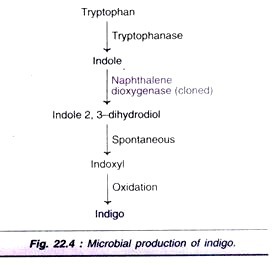ADVERTISEMENTS:
1.On line Mass Spectrometer Instrumental Analysis:
In on line systems environment and products need to be measured and are particularly valuable because the information can be sent directly to a computer.
During production important environmental data analyzed routinely throughout bioprocessing include dissolved oxygen (DO), pH and exhaust/effluent gas besides bio-product(s).
Measurement of many bio-products could be done , by sensing through oxygen probe biosensors having varying stability. Through years infrared analyser has been used to measure CO2 concentration in bioprocessing exhaust gas. Similarly a paramagnetic analyser has been used to measure the O2 concentration in bioreactor effluent gas.
ADVERTISEMENTS:
However, both instruments suffer from the same disadvantages, e.g. difficulty of maintenance, severe calibration drift and slow response time (r.t). One of the versatile instruments, e.g. mass spectrometer (MS) has been made available since the middle of the 1970’s and improvised gradually. It has been used in bio-product data analysis in more recent years. This more modern instrument runs unattended and measure CO2, O2, N2 and many other volatile bio-products with a high degree of accuracy. An illustration of measurement by GCMS is provided in the literature.
In principle the gas molecules entering the mass spectrometer are ionized and accelerated through a magnetic field. The flow paths of gas molecules of different masses bend to different degrees and are collected on prepositioned Faraday collector cups. An amplified signal output, proportional to the number of molecules collected, is sent to the process gas analysis instrument.
The numbers of gas components that can be analyzed depend on the pre-selection and analyzer design. For fermentation process biotechnology CO2, O2 and N2 are the essential gases to be estimated. In MS the response time of gas passing being fraction of a second for 0 to 90 percent response the analysis in the analyser is not only fast and specific but also has provision for on line data analysis of many process parameters, e.g. CO2 concentration (CDC), oxygen concentration (xc, % O2), RQ, CO2 evolution rate (CER), oxygen uptake rate (OUR), volumetric oxygen transfer coefficient (KLa), total oxygen consumed, cell dry weight and specific growth rate. In this instrument at room temperature the 90% restore time is defined by the length (L) and radius (r) of the tubing connecting the MS and the analysis probe by the relation below
t90 = 7.4 x 10-5 L2 r-1 (9.1)
ADVERTISEMENTS:
Here, t is in seconds and L and r are in centimeters. For instance, when L = 10 m and r = 0.8 cm, t90 = 90s consequently 2 minutes is a reasonable switching time where permanent gases are concerned. Besides on line analysis of permanent gases and vapours (like ethanol, methanol, aldelydes, formic acid, propanol, acetone, butanol, acetic acid, butyric acid etc.) many non volatile components can be analyzed off line. Therefore the MS is a versatile instrument for both aerobic and anaerobic fermentation processes.
Although this instrument is associated with many advantages in terms of accuracy calibration drift, response time, reliability, computer interfacing and operation, the major disadvantage lies in the fact that the instrument is expensive to purchase and its maintenance is complicated as well as expensive.
2. Light Scattering Instrumental Analysis:
The instruments like turbidometer, differential light scattering (DLS) photometer and quasielastic light scattering (QLS) photometer have been used for the estimation of cell/virus process parameters for different types of microorganisms and viruses.
A list of these light scattering techniques for measuring/obtaining different information’s is given in Table 9.1.
For more than four decades this analytical estimation has been useful for elucidating the conformation of bio-molecular systems in solution. The estimation techniques involving the elastic or quasielastic scattering of visible radiation have been applied mainly to the study of the mass and gross conformation of biological macromolecules in solution.
For example, a widely used light scattering (differential) equipment has been the ‘Zimm plot’ method. This method has been used to determine the molecular weight, radius of gyration, and second virial coefficient of a wide range of bio-polymeric molecules.
In simplest light scattering estimation of turbidity of a suspension of cells, the total loss of intensity is measured through scattering of the incident beam, using a conventional spectrophotometer. In fact this is a ‘Zero Scattering angle’ measurement. So, turbidity provides a conventional way of measuring the relative molecular mass, Mr of bio-molecular assemblies (with Mr ≥ 106) including viruses, yeasts, bacteria etc. Based on Rayleigh-Gaus- Debye (RGD) approximation and Camerini-Otero-Debye (COD) concept the value of Mr has been correlated with turbidity (τ) of the cell suspension.
The value of Mr measured at a finite concentration needs to be extrapolated to infinite dilution and expressed by the following relation in which C is the cell concentration (gl-1), τ = 2.303 (O.D.), H is a factor dependent on R.I. (n), wave length (X) in vacuo (λ0) and integrating Avogadro number (NA).
ADVERTISEMENTS:
Mr-1 = HQ limc→0 (C/τ)
The factor Q is defined as particle dissipation factor depending primarily on the size and shape of the cellular particles. This method has been applied to a range of bacteriophages (T2, T4, T5 and X) to determine their molecular weights and also has been compared with values determined by other methods, which showed accuracy better than ±10%.
The simple useful turbidimetry has been applied to both the vegetative cells and spores of bacteria with the aim of (i) estimating the concentrations of microorganisms and (ii) estimating their masses. Therefore, this technique monitors changes in cell number and mass. The DLS method has also been a valuable technique for determining Mr of viruses and bacteria using laser light source.
The advantages of lasers over traditional light sources are very high intensity, high collimation and narrow spread of wavelength, which give much improved angular resolution in intensity envelopes. The basic equation for angular dependence of light scattering by cells is given by
Use of this relation is consistent, no error is introduced and has been done in form of a biaxial extrapolation, ‘Zimm plot’ which shows a log relation of (C/RӨ) in the ordinate and [sin2 Ө/2 + 1 x 102 c] in the abscissa. The ‘Zimm plot’ carried out for vaccinia virus generated parametric values for this biosystem as given in Table 9.2. DLS technique has been used for application to bacteria like Serratia marcescens also.
3. Chromatographic Instrumental Analysis:
In chromatographic instrumental analysis chromatographic separations involve the retardation and separation of solutes from each other while flowing through a porous media by some carrier fluid. Depending on the dominant interactions chromatographic separation can be of several processes.
For example, the separation by ion exchange chromatography relies on the electrostatic interaction between a charged molecule (e.g. protein) and a stationary ion exchange resin carrying a charge of opposite sign. In this resolutional analysis for molecular separation, selecting a column begins with understanding that it is composed of two parts. The first is the resoluting packing material and second the container (stainless steel or plastic wall). The goal of all separations in this instrumental analysis is resolution of peaks as related by the resolution equation.
 In the above relations V0 is the volume of the system, V, and V2 are the retention volumes at the apex of each peak, W; is the peak width (i = 1, 2…etc.), K’ is the measure of retention, a describes the relative retention of the components by the stationary phase and N relates band broadening and retention volume. In HPLC α and K’ are the major controlling influences on resolution. Most HPLC packing’s today are made from silica, a durable and economical adsorbent.
In the above relations V0 is the volume of the system, V, and V2 are the retention volumes at the apex of each peak, W; is the peak width (i = 1, 2…etc.), K’ is the measure of retention, a describes the relative retention of the components by the stationary phase and N relates band broadening and retention volume. In HPLC α and K’ are the major controlling influences on resolution. Most HPLC packing’s today are made from silica, a durable and economical adsorbent.
The advantages of using high performance liquid chromatography (HPLC) in experiments like cloning include increased speed of separation, increased resolving power and increased cloning efficiencies. In experiments where all vectors, linkers and DNA fragments to be inserted into the vectors were purified by HPLC stearic exclusion chromatography.
Cloning could yield the number of trans-formants per microgram of vector DNA which was nearly 100 fold as measured by HPLC. Separation of tRNA molecules and restriction fragments by HPLC is now in common use. This separation based on size does not, of course, separate the individual tRNA species.
Reverse phase chromatography on octadecyl silica column, equilibrated with ammonium acetate buffers, has achieved separation of individual tRNA species to a limited extent. Usually tRNAs are eluted and separated by an acetonitrite gradient.
More recent developments in HPLC estimation technology used for bio-products relates to protein engineering cloning experiments. In this amino acid sequence of a known protein is especially redesigned in a predetermined manner at one or more amino acid residues. The purified cloned DNA specifying a protein is altered in a defined manner biochemically and this redesigned DNA will then direct the synthesis of the desired modified protein when expressed in the usual microbial culture.
4. Flow Injection Instrumental Analysis (FIIA):
ADVERTISEMENTS:
The characteristic of FIIA is based primarily on a combination of the following aspects:
(a) Reproducible injection of the sample to be analyzed into a non-segmented continuously flowing carrier stream.
(b) Control of the dispersion of the injected sample on its way from the point of injection to the detector.
Dispersion is the diffusion and dilution of the sample in the chosen system. Also, the dispersion degree allows the calculation of the necessary reagent concentrations and the optimization of the system regarding sensitivity and sample throughout. The techniques of FIIA systems are predominantly used as automated continuous flow analyzers, operating with well established methods for providing rapid and reliable results. One of the examples of FIIA system is “The Aquatech System.”
It is a modular and fully integrated microprocessor controlled FIIA system. In operation it includes fully automatic operation and data reporting. It consists of a specific controller and analyser with a built in detector unit (spectrophotometer, 400-600 nm) and a specific sampler. This system could be operated with manual or automatic sample introduction.
The chemical manifold in this instrument is an integral part of the ‘Method cassette’. Each dedicated ‘Method cassette’ contains the chemical manifold, optimized preinstalled pump, tubes and reagent bottles. This feature and construction allows for a very quick change of analysis.
ADVERTISEMENTS:
In most of the analytical laboratories FIIA systems are mainly used as automated continuous flow analysers, operating with well established methods and providing rapid and reproducible results. In such analysis a reaction column can be integrated into a normal FIIA system at the, required point.
There are a number of literature reports where immobilized enzymes have been used in reaction column. A typical example is provided in the following (Fig. 9.1) flow scheme for FIIA determination of starch in grain and feed using reaction columns with immobilized enzymes. The original sample for FIIA analysis was treated with termamyl (amylase) at 95°C. Various components are shown in Fig. 9.1.
More recently, an amperometric flow injection biosensor has been developed consisting of three channel FIIA system. This FIIA system involved a peristaltic pump, an injection port, enzyme reactor, a galvanic oxygen probe with a flow cell, a potentiostat and a 3-pen recorder. This FIIA system was developed in Japan which has a schematic diagram as shown in Fig. 9.2.
This system was used for simultaneous estimation of urea, creatinine and glucose with a single sample injection and one recorder. In this FIIA system the flow stream was split into three channels with a four direction connection after the sample injection. The channels involved urease and creatine deiminase (CRDI) for rejoining before L-glutamate dehydrogenase GLDH/ GLOD (L-glutamate oxidase). The mixed flow was further joined with GOD (Glucose oxidase) channel before electrode. For obtaining separate peaks corresponding to each channel, two delay coils of different lengths were set as in Fig. 9.2. Developments in FIIA Systems are occurring very fast.
5. PCR Instrumental Analysis:
In 1984 a team of scientists in Cetus Corporation developed the method of polymerase chain reaction (PCR). This method can produce large amounts of a specific DNA fragment from a complex DNA in a simple enzymatic reaction. The method is unique in selectivity, sensitivity and speed. It was devised quite a few years ago.
It involves an oligonucleotide-mediated enzymic amplification of a sample sequence in genomic DNA, resulting in an exponential increase of target DNA copies. In PCR instrumental analysis a DNA polymerase (usually the temperature stable Taq DNA polymerase) and dNTP are used to replicate a segment in a double stranded DNA, the procedure is carried out in presence of a large excess of two different synthetic oligonucleotides (extension primers), which anneal to the two sites flanking the segment of interest to initiate the replication.
This method is based on the cyclic repetition of a set of basic three steps. The first step of the reaction is annealing of the oligonucleotide primers to denatured (95 °C single stranded) genomic DNA followed by extension with Klenow DNA polymerase and deoxynucleotide triphosphates.
In the second step temperature is lowered (37 to 72°C, depending on experimental condition and purpose) to allow annealing of the primers to the separated strands of the DNA. In the third step DNA polymerase-mediated extension of the primer-template complex is allowed to proceed 1 to 4 min. at 72°C. This three step cycle is repeated in succession for 25 to 30 cycles.
PCR analysis has been used for RNA blot analysis (Northern, Western and Southern blottings), m-RNA phenotyping, and nuclease protection analysis for the study of short lived, low copy number m-RNA transcripts. Essential power of PCR method: (1) It is possible to amplify any small segment of DNA (e.g. < 5kb) if the 18-28 bp sequences at either end of the DNA sequence to be amplified are known. (2) Ready changes can be made in the flanking ends of the amplified genes to introduce suitable restriction endonuclease sites without the need for the extra steps involved in the site directed mutagenesis techniques. A schematic of the method is shown in Fig. 9.3.






